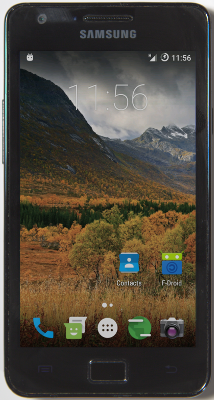
i9100  |
Device | Galaxy S II (GT-I9100) |
| Manufacturer | Samsung | |
| Release date | May 2011 | |
| Codename | i9100 |
|
| Status | Maintained | |
| Variants | GSM: GT-I9100 | |
| Latest images | Replicant 6.0 0003 |
To install Replicant on the Galaxy S II (GT-I9100), see the RecoveryInstallationWithHeimdall and MinorVersionUpgrade wiki pages.
Galaxy S 2 (I9100) Privacy/security issues
| Component | Name | Source | Status |
|---|---|---|---|
| SoC | Samsung Exynos 4210 | Linux kernel | Linux kernel support |
| GPU | Mali 400 | https://secure.wikimedia.org/wikipedia/en/wiki/Exynos | Linux kernel support, proprietary userspace |
| Audio Codec | Yamaha MC1N2 | Linux kernel | Linux kernel support (ALSA), free userspace: Yamaha-MC1N2-Audio/Tinyalsa-Audio |
| Modem | XMM6260 | Linux kernel | Free userspace implementation: Samsung-RIL/libsamsung-ipc |
| Wi-Fi | BCM4330 | Linux kernel | Linux kernel support, proprietary loaded firmware |
| Bluetooth | BCM4330 | Linux kernel | Linux kernel support, proprietary loaded firmware |
| NFC | PN544 | Linux kernel | Linux kernel support |
| GPS | GSD4t | http://www.csr.com/news/pr/release/455/en | Proprietary userspace, no free implementation: GSD4t |
| Accelerometer | K3DH | Linux kernel | Linux kernel support, free userspace |
| Compass | AKM8975 | Kernel sources | Linux kernel support, free userspace |
| Light | Capella CM3663 | Linux kernel support, free userspace | |
| Proximity | Capella CM3663 | Linux kernel support, free userspace | |
| FM Radio | SI4709 | Linux kernel | Linux kernel support |
| Camera (back) | Fujitsu M5MO | Linux kernel support, free userspace | |
| Camera (front) | Samsung S5K5BAFX | Linux kernel support, free userspace | |
| Touchscreen | Atmel MXT224 | Linux kernel support | |
| Display | LD9040 | Linux kernel support | |
| Power Management IC (PMIC) | Maxim MAX8997 | Kernel sources | Linux kernel support |
WARNING some content may not be the same on your device
| PIT | Linux name | mount point | partition type | block device | Description |
|---|---|---|---|---|---|
| GANG | |||||
| BOOT | |||||
| EFS | EFS | /efs | ext4 | mmcblk0p1 | modem data partition |
| SBL1 | SBL1 | mmcblk0p2 | |||
| SBL2 | SBL2 | mmcblk0p3 | |||
| PARAM | PARAM | mmcblk0p4 | |||
| KERNEL | KERNEL | None | zImage | mmcblk0p5 | boot partition, See GalaxySIIGTI9100 for more details |
| RECOVERY | RECOVERY | None | zImage | mmcblk0p6 | recovery partition, See GalaxySIIGTI9100 for more details |
| CACHE | CACHE | /cache | ext4 | mmcblk0p7 | |
| MODEM | MODEM | mmcblk0p8 | |||
| FACTORYFS | FACTORYFS | /system | ext4 | mmcblk0p9 | system partition |
| DATAFS | DATAFS | /data | ext4 | mmcblk0p10 | |
| UMS | UMS | /mnt/media_rw/xxxx-xxxx | vfat | mmcblk0p11 | user data |
| HIDDEN | HIDDEN | /preload | ext4 | mmcblk0p12 |
The RECOVERY partition is not used by the stock bootloader.
What happens with the stock OS and old versions of Android distributions is that both the boot kernel and the recovery are in the KERNEL partition.
In practice in Replicant 6.0:However as distributions like LineageOS tend to use recoveries like TWRP, it was a problem for such distributions.
So people from XDA came with a scheme called isorec which made it into LineageOS 13.
And Replicant 6.0 is based on LineageOS 13, that is probably in Replicant too, even if it's not used for the Replicant installation and recoveries.
So if the RECOVERY partition contains valid lzop-compressed data, which contains a valid cpio archive, then the image flashed in KERNEL will use that as an initramfs for the recovery.
These documents are the propriety of Samsung Electronics and are not hosted by the Replicant project.